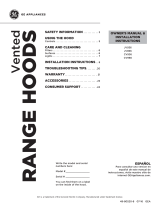
Instrucciones
de instalación
¿Preguntas? Llame al 800.GE.CARES (800.432.2737) o visite nuestro sitio Web en: GEAppliances.com
INSTRUCCIONES DE INSTALACIÓN
ANTES DE COMENZAR
Lea estas instrucciones por completo y con
detenimiento.
•
IMPORTANTE ³ Guarde estas
instrucciones para el uso de inspectores
locales.
•
IMPORTANTE ³ Cumpla con todos los
códigos y ordenanzas vigentes.
•
Nota al instalador – Asegúrese de dejar estas
instrucciones con el Consumidor.
• Nota al consumidor – Conserve estas
instrucciones para referencia futura.
• Nivel de capacidad – La instalación de esta
campana de ventilación requiere capacidades
mecánicas y eléctricas básicas.
• Tiempo de finalización – Aproximadamente
de 1 a 3 horas.
• El instalador tiene la responsabilidad de
efectuar una instalación adecuada.
• La Garantía no cubre las fallas del producto
debido a una instalación incorrecta.
PARA SU SEGURIDAD:
ADVERTENCIA: Antes de comenzar
la instalación, desconecte la energía del panel de
servicio y bloquee los medios de desconexión
para evitar el accionamiento de la energía de
manera accidental. Cuando los medios de
desconexión de servicio no pueden bloquearse,
coloque sobre el panel de servicio un dispositivo
de advertencia bien visible, como una etiqueta.
PRECAUCIÓN: Debido al peso
y tamaño de estas campanas de ventilación y
para reducir el riesgo de lesiones personales o
daños al producto, SE NECESITAN DOS
PERSONAS PARA REALIZAR UNA INSTALACIÓN
CORRECTA.
Pared de Vidrio
Campanas de Ventilación de la Chimenea
PVW7301, PVW7361
(991.0364.613 rev 1) 31-11007 04-15 GE
ADVERTENCIA: PARA REDUCIR EL
RIESGO DE INCENDIO, DESCARGA ELÉCTRICA
O LESIONES A PERSONAS, CUMPLA CON LOS
SIGUIENTES PUNTOS:
A. El trabajo de instalación y el cableado
eléctrico deben ser realizados por una
persona(s) calificada de acuerdo con todos los
códigos y estándares aplicables, incluyendo
construcciones resistentes al fuego.
B. Es necesario contar con suficiente
cantidad de aire para una combustión
y salida de gases adecuadas a través
del conducto (chimenea) del equipo de
consumo de combustible, a fin de evitar
ráfagas de aire. Siga las pautas del
fabricante del equipo de calefacción y
los estándares de seguridad, tales como
aquellos publicados por la Asociación
Nacional de Protección contra Incendios
(National Fire Protection Association,
NFPA), la Sociedad Estadounidense
para la Calefacción (American Society for
Heating), los Ingenieros de Refrigeración y
Acondicionadores de Aire (Refrigeration and
Air Conditioning Engineers, ASHRAE) y las
autoridades de los códigos locales.
C. Al cortar o perforar una pared o un
cielorraso, no dañe el cableado eléctrico y
de otros servicios ocultos.
D. Los ventiladores con conducto siempre
deben contar con ventilación hacia el exterior.
E. Desconecte el disyuntor de habitaciones
adyacentes mientras esté trabajando.
ADVERTENCIA: A FIN DE
REDUCIR EL RIESGO DE INCENDIOS, USE
SÓLO CONDUCTOS DE METAL.


















